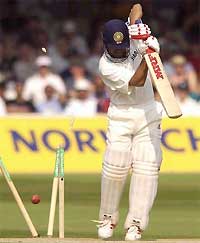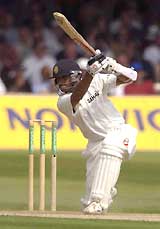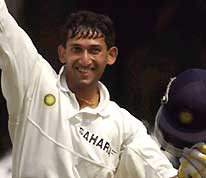Front-runners, not favourites
Daniel Laidlaw
The first Test has made a mockery of the notion either that India began the
match and even series as favourites, or that England fielded a sub-standard
XI for the Lord's clash ready to be over-run by the imaginary Indian
powerhouse. As the proverb goes, a champion team will always defeat a team
of champions, and it was easy to see which was which in the first Test.
Whereas England were purposeful and at all times appeared to be adhering to
a plan, India were too often erratic with the ball and directionless with
the bat. Given how England controlled the match, we should not so much
wonder why India failed to maintain their few auspicious spells - like when
England were 78/3 on day one, or Sehwag and Dravid had reached 128/1 on day
two - but how those periods also managed to escape England's otherwise full
command.
The damning impression left by India's batsmen in the first Test was one of
being front-runners. Impressive when they began well or sustained an early
partnership, when confronted with adversity they lacked the toughness and
sense of requirement to intensify their efforts and fight back until it was
far too late, when the result was not in dispute.
 Chief culprit in this regard was Sachin Tendulkar. Even given the
ill-advised use of Nehra as nightwatchman the evening before, the lack of
initiative shown against the commendable control of Flintoff and Hoggard and
then the fall of Dravid which compounded the impasse, at 162/4 on the third
day the fate of the Test was in the balance. It had mostly gone wrong for
India up to that point, but was hardly so disastrous as to make the
situation hopeless. A re-appraisal of the state of the game, a recognition
of the need to adjust and establish some momentum, and with a little spirit
the game could have been more safely steered towards what should have been
its natural destiny given the relative batting-to-bowling strength of both
teams -- a draw.
Chief culprit in this regard was Sachin Tendulkar. Even given the
ill-advised use of Nehra as nightwatchman the evening before, the lack of
initiative shown against the commendable control of Flintoff and Hoggard and
then the fall of Dravid which compounded the impasse, at 162/4 on the third
day the fate of the Test was in the balance. It had mostly gone wrong for
India up to that point, but was hardly so disastrous as to make the
situation hopeless. A re-appraisal of the state of the game, a recognition
of the need to adjust and establish some momentum, and with a little spirit
the game could have been more safely steered towards what should have been
its natural destiny given the relative batting-to-bowling strength of both
teams -- a draw.
But Tendulkar, restrained by the consistent accuracy of the attack, lashed
out at a wide one from White to expedite India's limp descent. Ganguly, too,
departed disappointingly when he reached for a delivery from Flintoff
without getting to the pitch to be caught square. Wickets five and six were
precious, for the tail seemed to begin with Ratra, the belated effort by
Agarkar in the second innings notwithstanding.
Quality Test teams have a certain resolve, a strength and belief, that
prevents successive wickets, a frequent hazard, from becoming full-scale
collapses on a regular basis. In the first Test, India's batting had a sense
of fallibility upon the fall of top-order wickets, which England scented and
exploited. Unrelentingly disciplined, as a group the seam attack kept India
off balance and shared the spoils, comfortably setting the game up for a
second innings declaration, which Vaughan and Crawley duly ensured.
 In the second innings, at least India's specialist batsmen, with the
possible exceptions of Dravid and Laxman, could not be accused of perishing
to poor shots. Lucky not to lose both Jaffer and Sehwag to the variable
bounce of the new ball (when, again, it was bemusing Hussain held Jones back
instead of further exploiting conditions with his pace), the batsmen played
the situation as reasonably as could have been expected, but were just
charged with too great a task. Or so it appeared before Agarkar's knock.
In the second innings, at least India's specialist batsmen, with the
possible exceptions of Dravid and Laxman, could not be accused of perishing
to poor shots. Lucky not to lose both Jaffer and Sehwag to the variable
bounce of the new ball (when, again, it was bemusing Hussain held Jones back
instead of further exploiting conditions with his pace), the batsmen played
the situation as reasonably as could have been expected, but were just
charged with too great a task. Or so it appeared before Agarkar's knock.
The main criticism that could be levelled was that Sehwag, Tendulkar, Dravid
and Laxman all fell to bowlers commencing new spells. The need for increased
watchfulness could be argued; then again it may simply have been a credit to
the way Jones and Hoggard started their spells.
Jones waited 12 overs before seaming one in second ball to beat Sehwag's
defensive shot; Vaughan had Jaffer caught at slip pushing forward to an arm
ball; and Tendulkar's straight drive was defeated by Hoggard moving a full
delivery back in after the previous couple went away outside off. Ganguly
copped a bad decision when umpire Koertzen appeared caught up in the theatre
of an appeal the ball after a big wicket, and as straightforwardly as that
the already unlikely aspiration of salvaging a draw was doomed.
 Without disrespecting Agarkar's hitherto well-disguised batting ability and
the determination he showed in a losing cause, if he is the top scorer then
the specialist batsmen have to some degree been shown up. Day five diligence
by Agarkar, Laxman and Nehra should be seen as encouraging, as India have
folded under similar circumstances in the past, but in a way it is still a
sign of having no feel for when that attitude is really required.
Without disrespecting Agarkar's hitherto well-disguised batting ability and
the determination he showed in a losing cause, if he is the top scorer then
the specialist batsmen have to some degree been shown up. Day five diligence
by Agarkar, Laxman and Nehra should be seen as encouraging, as India have
folded under similar circumstances in the past, but in a way it is still a
sign of having no feel for when that attitude is really required.
At least with Kumble, Nehra and Agarkar, their bowling performances were
mitigated either by inexperience, the unhelpful surface or both.
Disappointing, but not dishonourable. There were no such excuses for
Tendulkar, Ganguly (first innings) and Dravid, twice out when
well-established. Hussain, Vaughan and Crawley each peeled off hundreds and
the quality of India's guns should likewise have shone through, but it did
not.
Dravid shed his masochistic proclivity in the second innings and was plainly
furious to get out chopping Giles onto his stumps. One expects he'll make up
for it, and the positive is that Tendulkar and Ganguly are unlikely to fail
for two Tests in a row. On the negative side, other pitches may not be so
batsman-friendly and it's unrealistic to expect considerable improvement
from Kumble and the seam attack, relative to the prevailing conditions.
Fortunately, it's a four-Test series, and India are not immediately
condemned to the likelihood of another series loss, as they would have been
if it were a standard three-match affair. However, no-one should again make
the mistake of considering India pre-Test favourites. There's still too much
to prove before that is appropriate.
More Columns
Mail Daniel Laidlaw